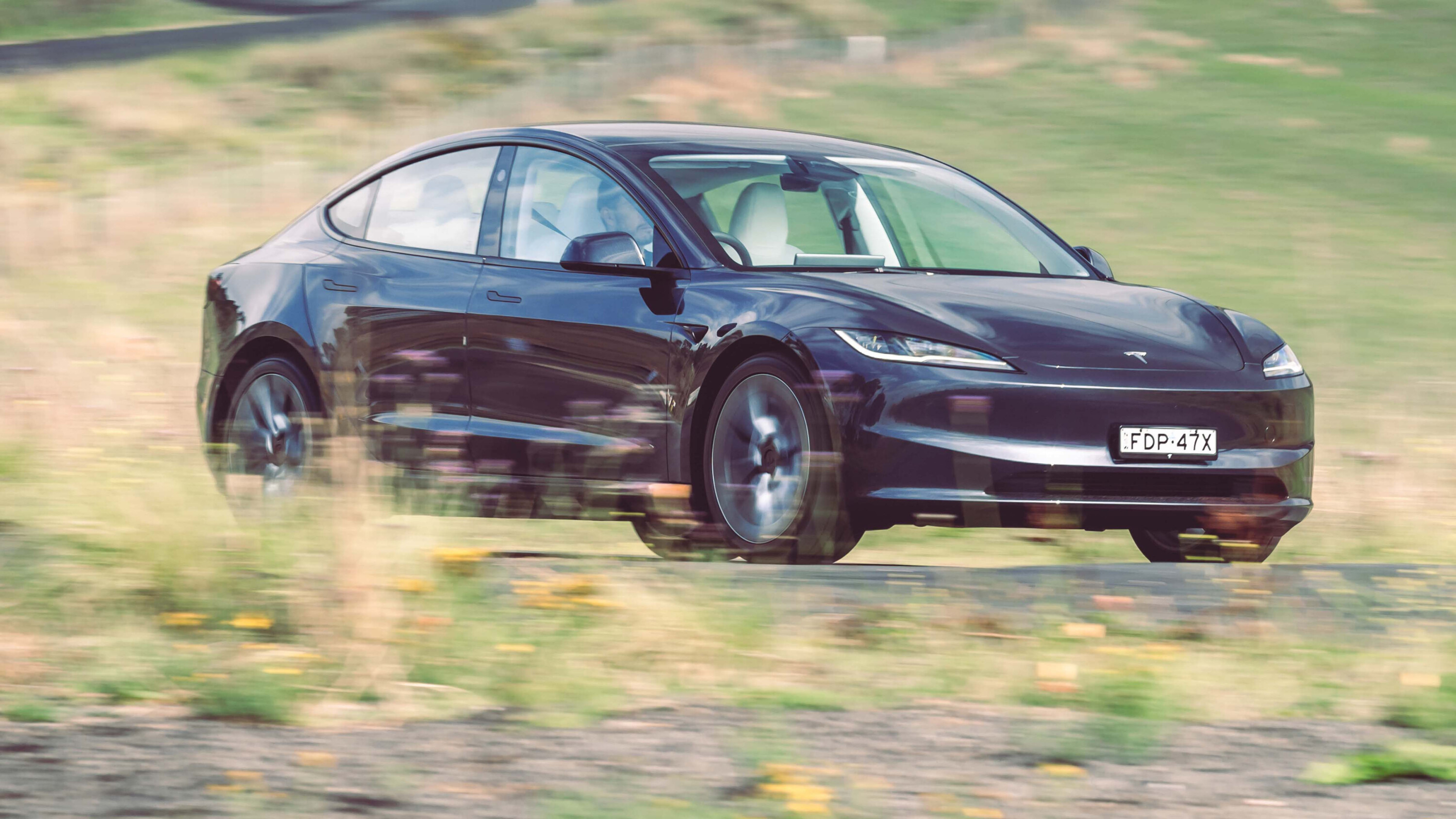
Score breakdown
Things we like
- Efficiency and performance even on base model
- Advanced, up-to-date tech
- Access to most Tesla Supercharger, Destination chargers
- Modern, improved quality interior
Not so much
- Speedo not in front of driver; no head-up display
- Trickle charging cable no longer included
- Fidgety low-speed ride
- Ambiguous exterior design
The Tesla Model 3 is an electric medium sedan, boasting high-tech features, a minimalist interior, and an efficient design.
It was launched in Australia in 2019, but has been sold overseas since 2017. The model was updated in 2021 with features such as a redesigned interior centre console, matte black exterior trims, an electric tailgate, and larger battery packs.
In late 2023, a more comprehensive update was launched in Australia with a more upmarket design, new technology and slightly better driving range.
The popular Model 3 sedan is currently offered in three variants. These include the rear-wheel drive (RWD) with a ‘standard range’ battery, while the more expensive Long Range and Performance versions feature a ‘long range’ battery. The Model Y electric SUV is based on the Model 3 platform.
Unlike other car brands, Tesla does not disclose specific powertrain and battery specifications. Some figures in this article are estimates from the EV Database [↗].
JUMP AHEAD
- Pricing
- What body styles are available for the Model 3?
- What features are standard in every Model 3?
- What key features do I get if I spend more?
- How safe is the Tesla Model 3?
- How comfortable & practical is the Tesla Model 3?
- How much boot space does the Tesla Model 3 offer?
- I like driving, will I enjoy this car?
- Which version of the Model 3 provides the longest range?
- What is the Model 3’s towing capacity?
- How long is the warranty & what are the Model 3’s servicing costs?
- Which version of the Model 3 does Wheels recommend?
- What are the Model 3’s key rivals?
- What might annoy me?
- Does any upgrade have a downside?
- What might I miss that similar cars have?
- What’s the infotainment system like?
- Where does Tesla make the Model 3?
- Are there plans to update the Model 3 soon?
Pricing
We endeavour to keep this review up-to-date, but Tesla prices have a tendency to fluctuate periodically with little warning. Make sure to check out our Model 3 pricing story for the most up-to-date figures.
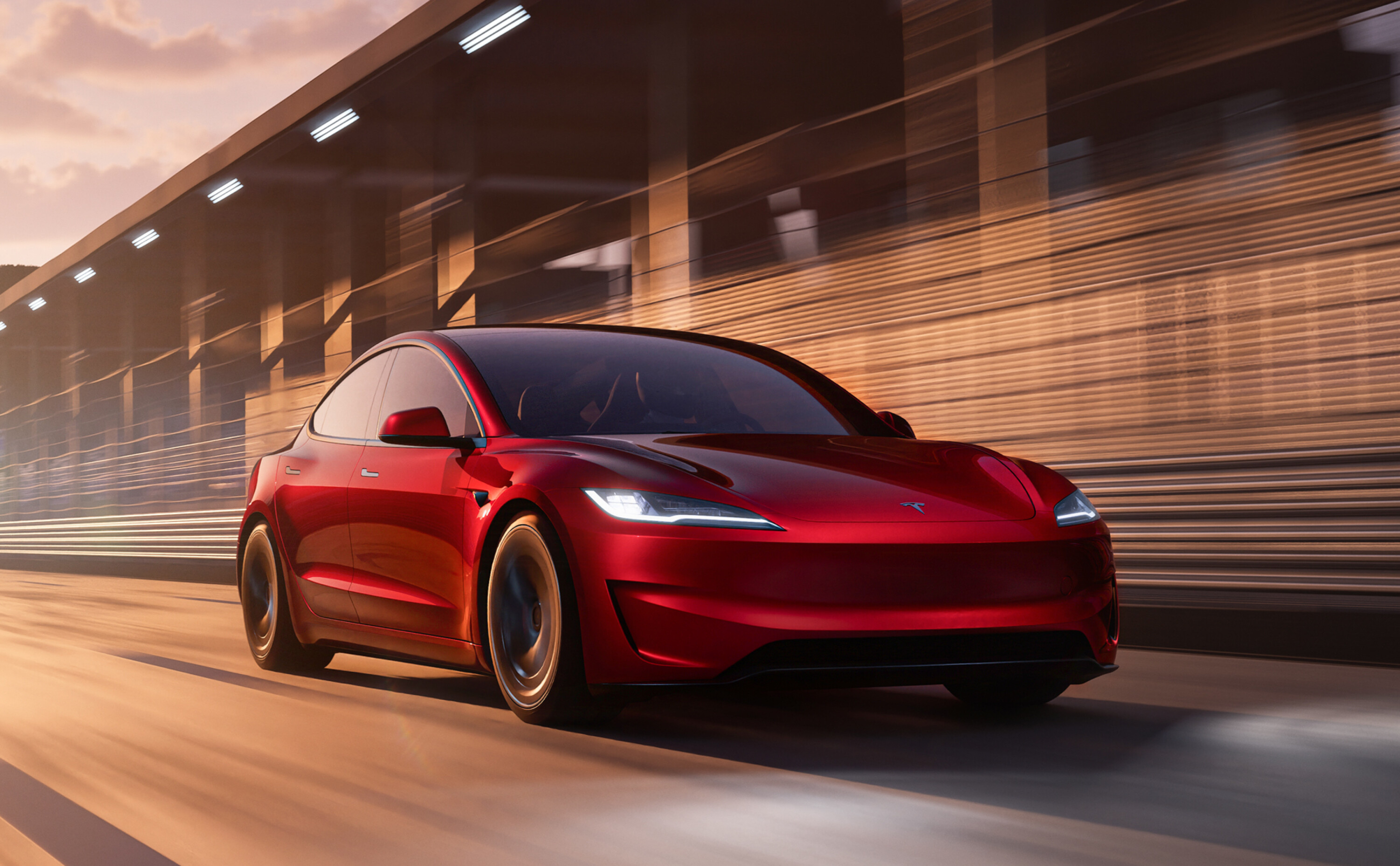
What body styles are available for the Tesla Model 3?
Five-door, five-seater sedan only.
It is classed as a medium sedan, even though its length is closer to that of a Hyundai i30 Sedan that sells in the small segment than that of a Toyota Camry that occupies the medium segment.
Officially competing in Australia’s passenger cars above $60K segment, the Model 3 is priced in line with petrol-engined sedans from luxury car brands.
What features are standard in every Tesla Model 3?
We endeavour to keep this review up-to-date, but Tesla tends to make minor ‘running changes’ without notice and public disclosure compared to other brands. The features below are correct as at the time of publication.
The base Tesla Model 3 RWD features much of the available equipment as standard, with a single electric motor and a 57.5kWh usable lithium-iron-phosphate (LFP) battery (according to EV Database). It includes:
| 2024 Tesla Model 3 Rear-Wheel Drive standard features | |
|---|---|
| 18-inch u2018Photonu2019 aero covered alloy wheels | Fixed tinted panoramic glass roof |
| Animal hide-free black interior | Acoustic glass (front, side and rear) |
| 15.4-inch touchscreen with over-the-air (OTA) software update capability | Ambient lighting dashboard and door strips (200+ colour combinations) |
| 8.0-inch rear passenger climate and entertainment touchscreen | u2018Tesla Visionu2019 camera-only u2018Basic Autopilotu2019 active safety assistance features |
| Built-in Google Maps with automatic Supercharging stop planning | Reversing camera with blind-spot view side cameras |
| Music and video streaming apps, arcade games, Bluetooth, and voice control | Heated and ventilated front seats |
| Tesla mobile app connectivity with ultra-wideband (UWB) support for phone key | Heated rear seats |
| Standard Connectivity for up to eight years, Premium Connectivity trial for first 30 days | Heated steering wheel |
| Built-in Dashcam and Sentry Mode recording (128GB USB stick included) | Electrically adjustable driver and front passenger seat |
| Nine-speakers with amplifier | Full LED headlights with auto high beam and integrated fog lights |
| Dual Qi wireless charging pads | Full LED tail-lights with rear fog lights |
| 65-watt USB-C charging ports | Auto power folding, dimming, heated wing mirrors |
| Dual-zone climate control with hidden front and rear air vents, Keep Climate On, camp mode and dog mode | Power tailgate |
| Pedestrian warning u2018Boomboxu2019 external speaker | Camera-based automatic wipers |
| Flush exterior door handles with matte black exterior trim | |
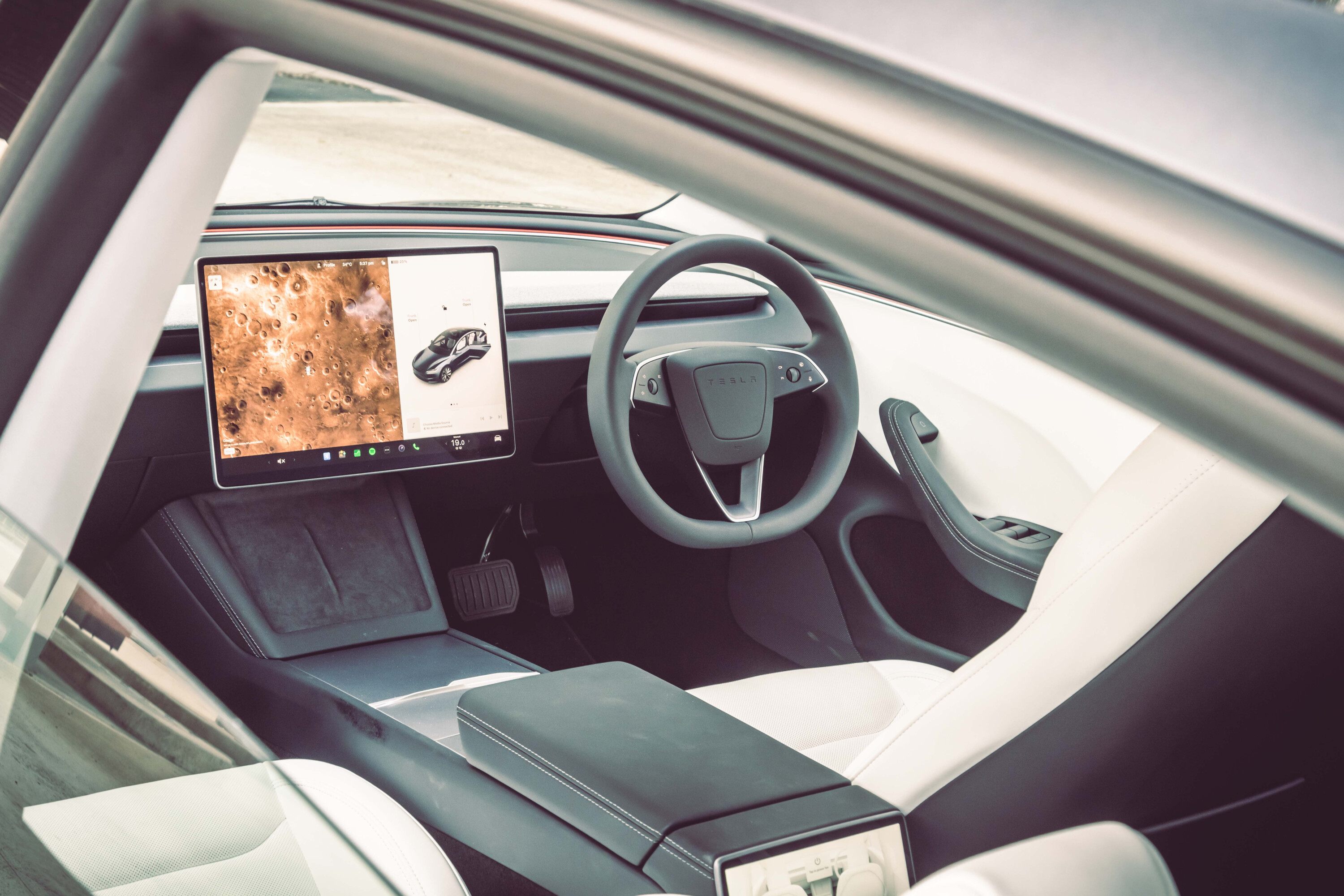
What key features do I get if I spend more?
We endeavour to keep this review up-to-date, but Tesla tends to make minor ‘running changes’ without notice and public disclosure compared to other brands. The features below are correct as at the time of publication.
The mid-pack Long Range also gains a larger 75kWh usable nickel-manganese-cobalt (NMC) battery (according to EV Database), dual electric motors and all-wheel drive traction, plus:
| 2024 Tesla Model 3 Long Range features (In addition to Rear-Wheel Drive) | |
|---|---|
| 17-speakers with dual subwoofers and amplifiers | Black artificial suede interior door material |
The flagship Performance gets a more powerful dual-motor tune, and:
| 2024 Tesla Model 3 Performance features | |
|---|---|
| 20-inch u2018Warpu2019 alloy wheels | Unique front and rear bumpers |
| Performance front brakes, red-painted brake callipers | Carbon fibre rear spoiler |
| Lowered adaptive suspension | Carbon fibre-look interior trim |
| Alloy pedals | Track mode |
| Sports seats | Increased top speed to 262km/h |
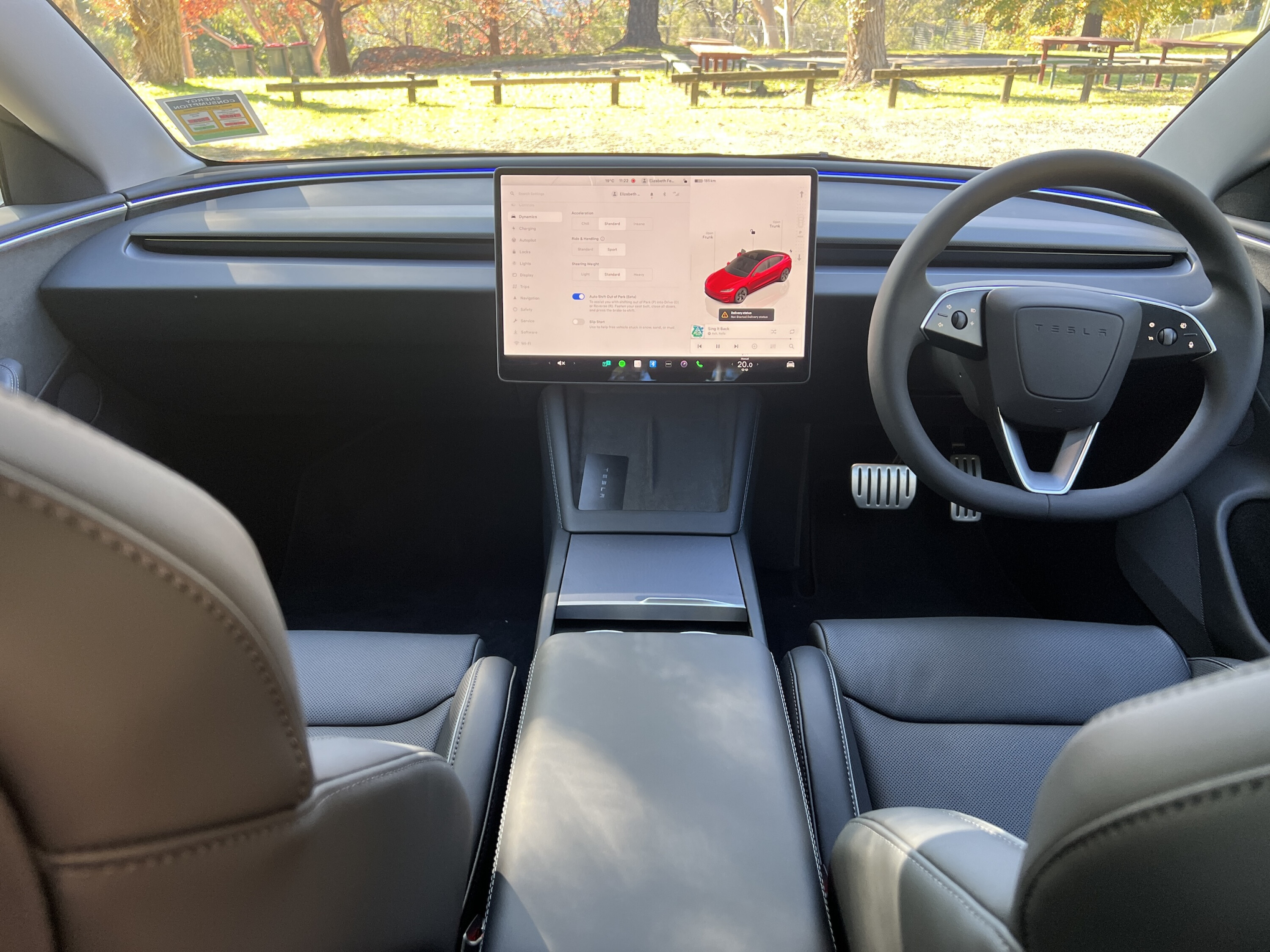
| 2024 Tesla Model 3 options | |
|---|---|
| 19-inch u2018Novau2019 alloy wheels (RWD and Long Range only) ($1800) | Enhanced Autopilot ($5100) |
| White interior ($1500) | u2018Full Self-Drivingu2019 Capability ($10,100) |
| Premium Connectivity ($9.99/month) | Tesla Mobile Connector trickle charging cable ($550) |
| 2024 Tesla Model 3 colours | |
|---|---|
| Pearl White Multi-Coat | Standard |
| Solid Black | $1500 |
| Deep Blue Metallic | $1500 |
| Stealth Grey | $2300 |
| Ultra Red | $2600 |
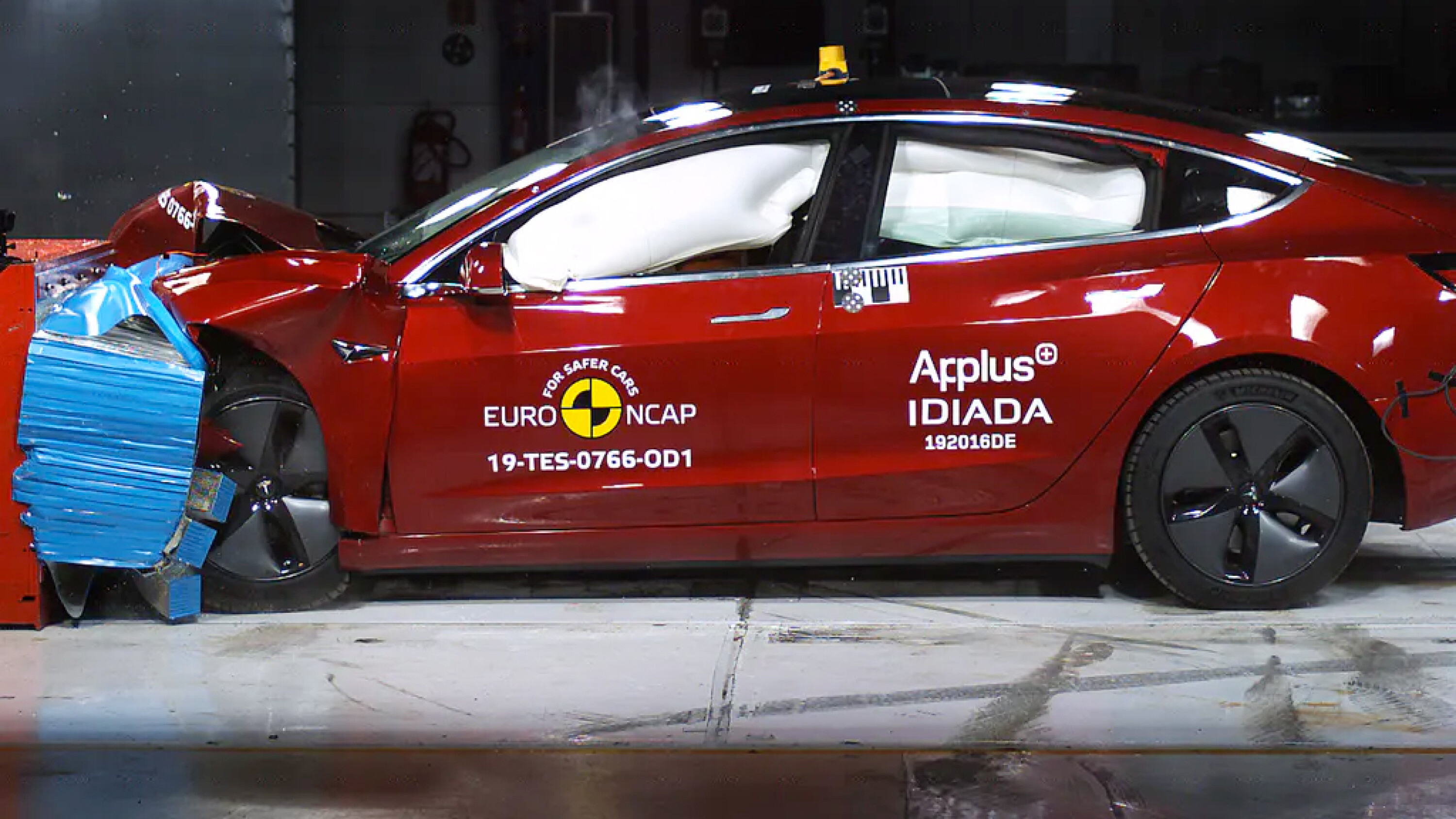
How safe is the Tesla Model 3?
The updated Tesla Model 3 remains unrated by the Australasian New Car Assessment Program (ANCAP).
Pre-facelift models received a five-star ANCAP safety rating under older 2019 testing criteria.
Assessment scores included: 96 per cent for adult occupant protection, 87 per cent for child occupant protection, 74 per cent for vulnerable road user protection, and 94 per cent for safety assist systems.

The electric sedan uses camera-only active safety assistance technologies. It features ‘Basic Autopilot’ as standard, including front auto emergency braking (AEB) with vehicle/pedestrian/cyclist/junction detection, rear AEB, adaptive cruise control with lane-centring assist, lane-keep assist, and blind-spot monitoring.
A reversing camera, blind-spot monitoring, and blind-spot view cameras come as standard.
About those ultrasonic sensors…
According to Tesla [↗], it is phasing out ultrasonic parking sensors globally in favour of camera-only based systems.
However, at the time of publication, Australian vehicles from the Shanghai Gigafactory appear to still be delivered with physical sensors, with Tesla not specifying an end date.

How comfortable and practical is the Tesla Model 3?
The Model 3 sedan includes an interior made from animal-free black trim as standard on all variants. However, in our experience, the black vinyl seats can become sweaty on hot days.
Potentially alleviating this issue is the option of an all-white cabin design, available for an extra $1500.
Keeping the cabin cool on warm days isn’t helped by the fixed panoramic glass roof either, which doesn’t come with a built-in sunshade – despite Tesla’s strong ultraviolet protection claims (after all, glass is glass).
The rear seats offer good legroom, with the ground-up EV platform enabling a flat floor. However, the higher floor (needed to accommodate batteries) and low-slung bench result in a knees-up seating position. Foot space is also limited and the sloping rear roofline restricts headroom.
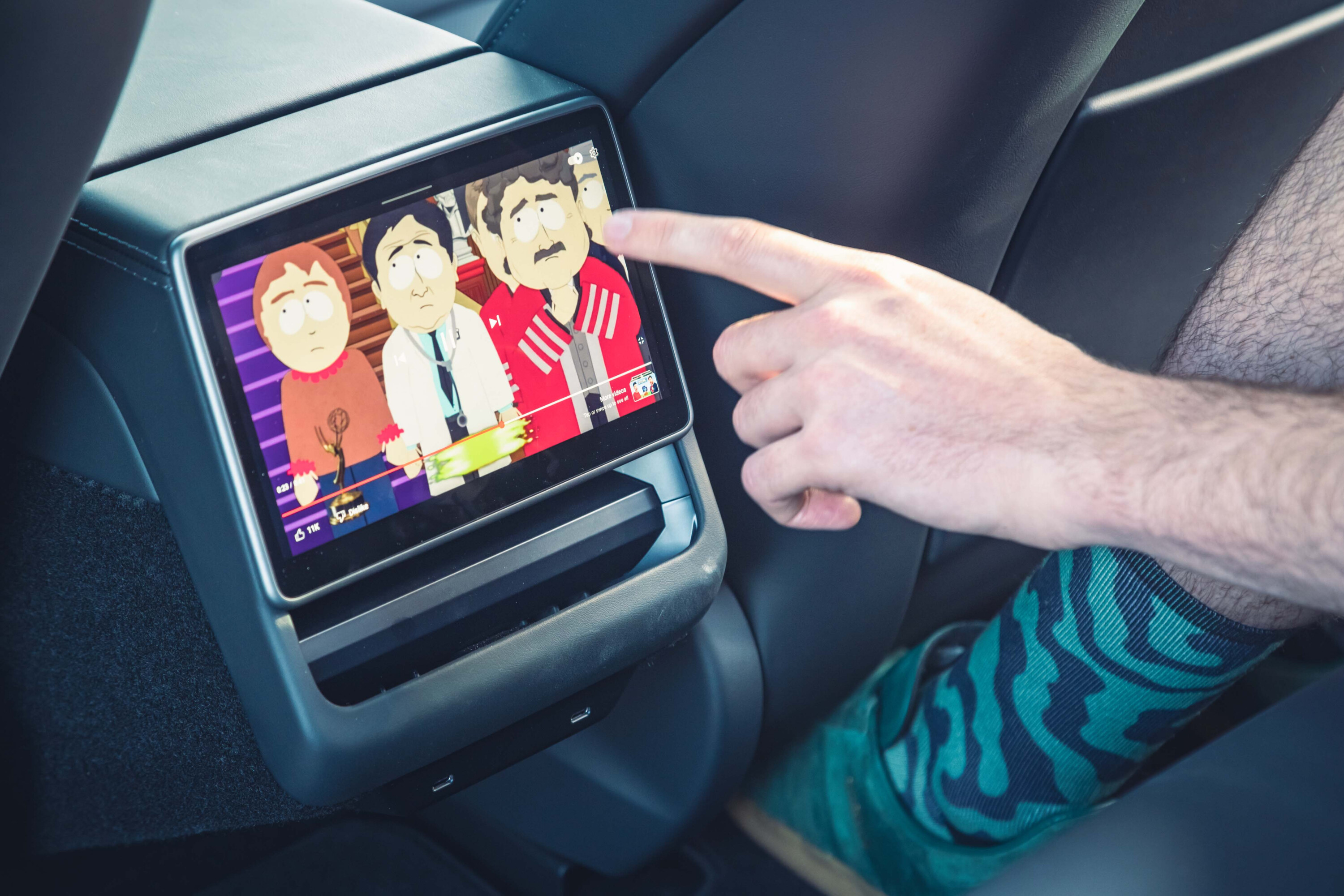
The rear bench has two ISOFIX child seat anchor points in the outboard seats and three top-tether points.
All seats (including the rear middle seat) feature three-stage heating functionality as standard. Air ventilation is offered for the front seats.
The Model 3’s dual-zone climate control is powered by ‘invisible’ air vents across the front dashboard that must be adjusted via the central touchscreen, while rear passengers have physical centre console vent controls.
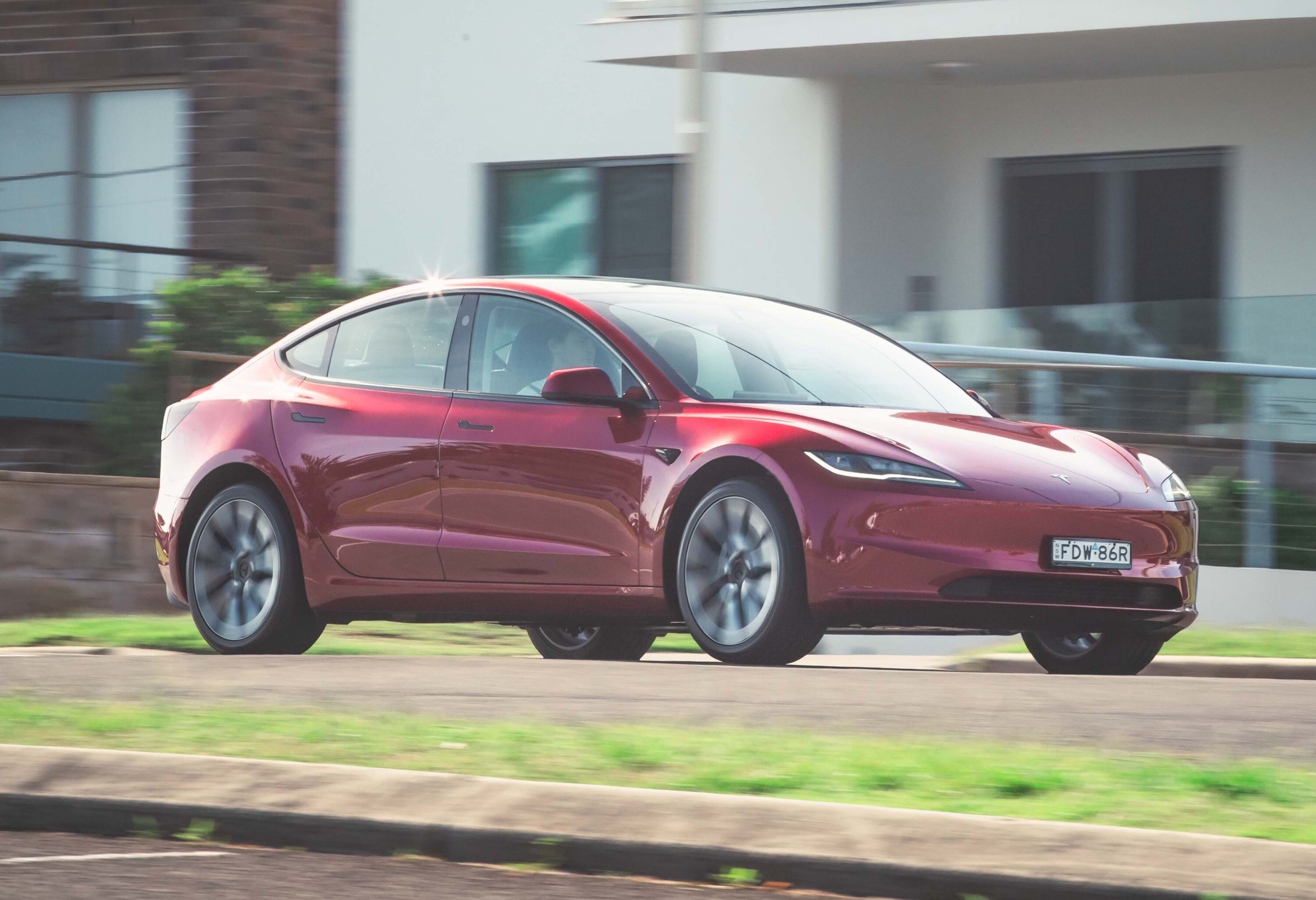
Tesla’s cabin overheat protection function automatically activates the climate control to cool down the interior when the temperature exceeds 40ºC, but it doesn’t operate when the battery is below 20 per cent charge.
Further related benefits include ‘Keep Climate On’, camp mode, and dog mode operation that all run the air-conditioning system while the vehicle is stationary and locked – features still rarely found in other EVs today.
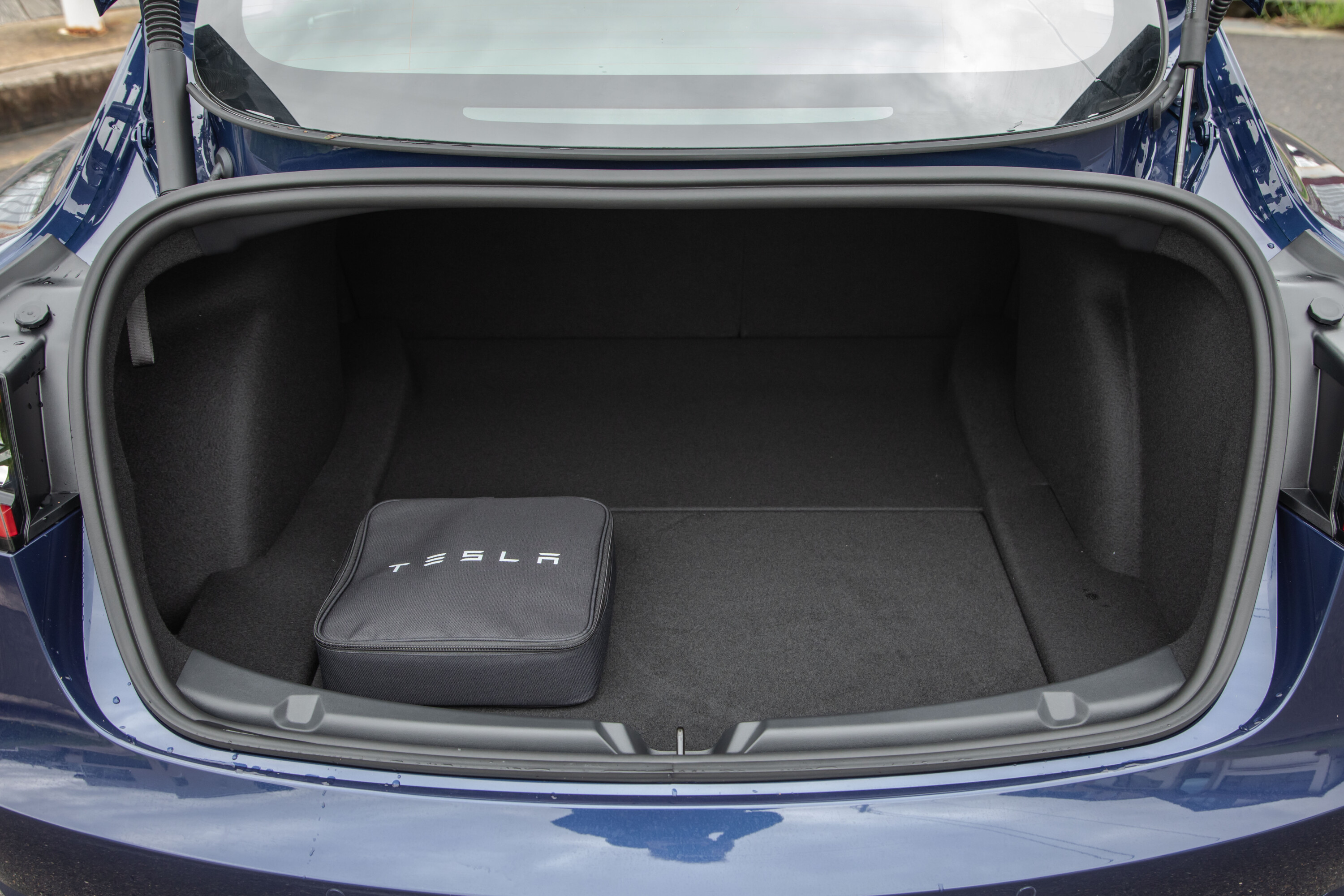
How much boot space does the Tesla Model 3 offer?
The Tesla Model 3 sedan has a 561-litre boot volume, which includes the underfloor well, and a sizeable 88-litre ‘frunk’ (front trunk) storage space under the bonnet.
However, the company doesn’t specify a cargo capacity figure for when the rear seats are folded down via their 60:40 split.

The Model 3’s boot aperture is more restricted than that of its Model Y SUV counterpart, but the space is usefully long and has a decent width.
The underfloor storage is generously deep, a space where the rear motor and speaker hardware would usually limit storage capacity in other EVs.
Electric boot opening and closing is operated via the boot lid button, the touchscreen inside, or the Tesla smartphone app, but it lacks an automatic hands-free function.
Will I enjoy driving the Tesla Model 3?
Drivers will be pleased with the Model 3’s quick and precise steering, responsive front end, and low centre of gravity across all variants.
Even though the entry-level variant is only rear-wheel drive, it maintains grip and traction in damp conditions, with more-forgiving Hankook tyres than the Michelin Pilot Sport 4S sports rubber used previously.
According to EV Database, the single-motor rear-wheel drive Model 3 generates 208kW of power and 420Nm of torque, with Tesla claiming a 6.1-second 0-100km/h time.
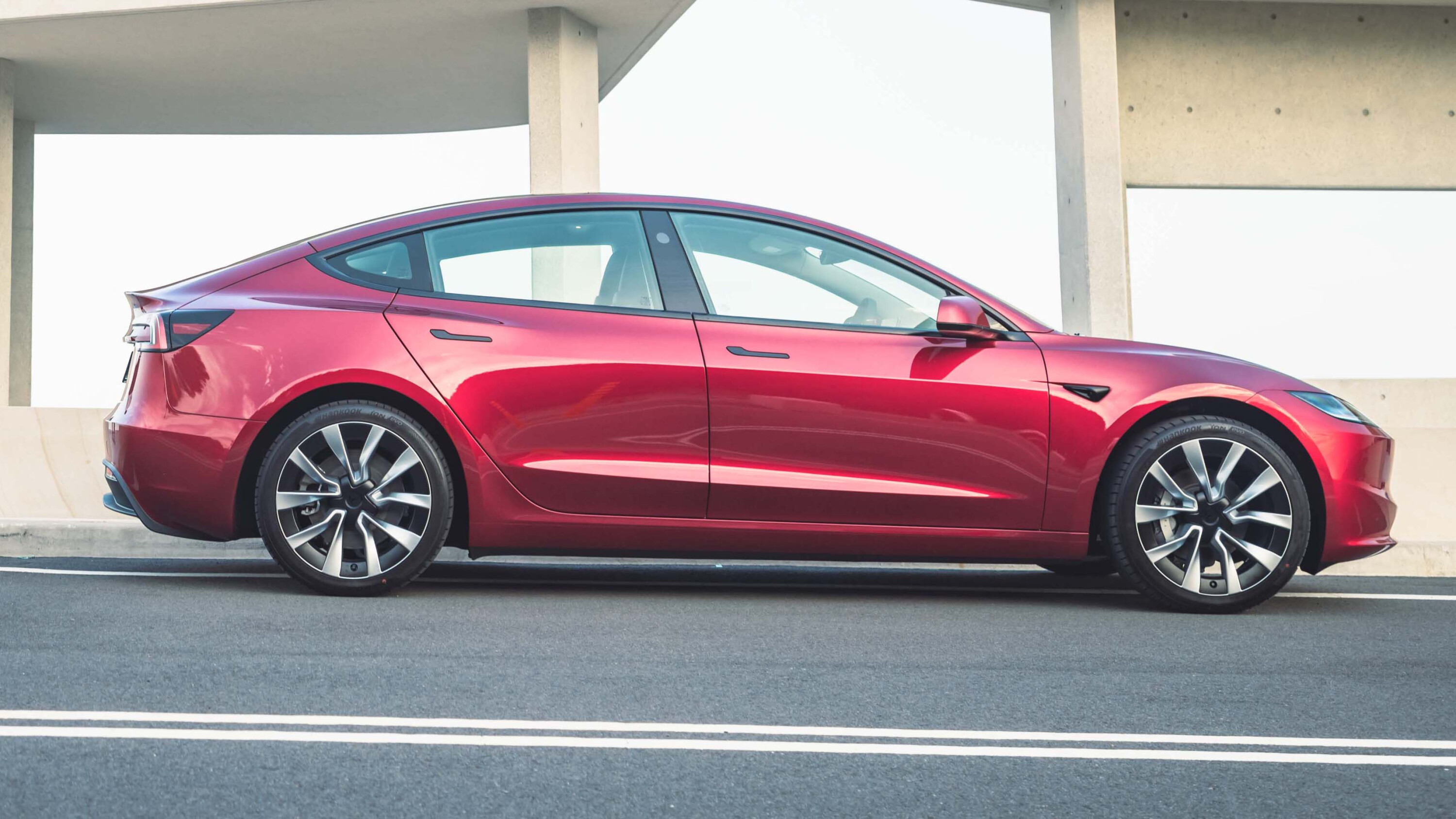
The base model already provides satisfyingly strong and smooth acceleration, outperforming most combustion-engined cars at the lights.
Stepping up to the all-wheel drive Long Range introduces dual electric motors, producing a combined 366kW and 493Nm. Tesla claims a 4.4-second 0-100km/h acceleration time for this model.
Meanwhile, the Performance variant increases the output to 461kW and 741Nm, achieving a 3.1-second 0-100km/h time. However, it isn’t entirely realistic because Tesla subtracts a one-foot rollout.
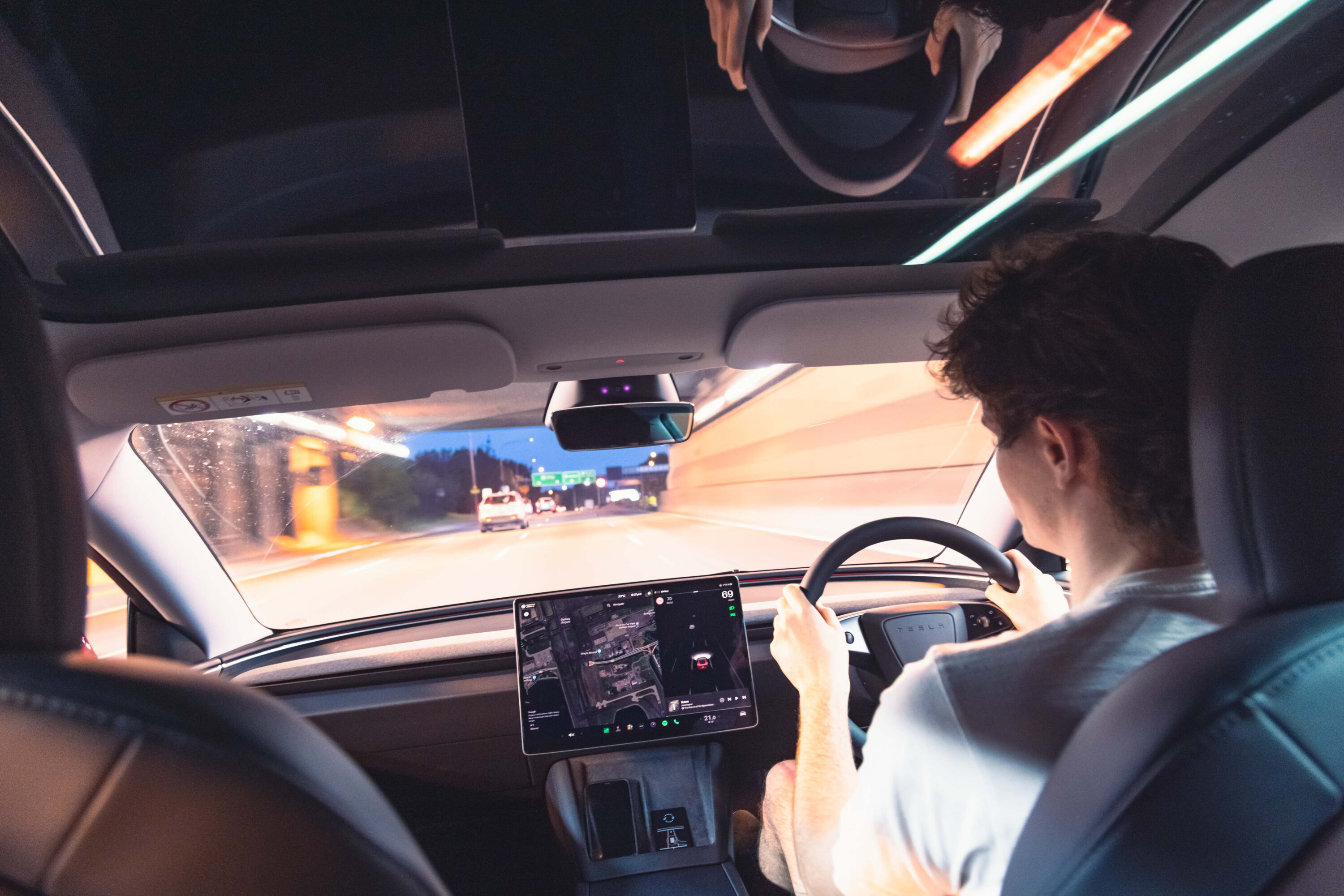
This variant also raises the top speed to 262km/h (not that you’ll reach this on most Australian public roads) and includes performance front brakes, lower-profile 20-inch wheels, lowered suspension, and a dedicated Track drive mode.
For a more relaxed drive, Tesla provides a ‘Chill’ drive mode to dampen the intensity of the acceleration.
Conversely, Tesla’s regenerative braking system quickly becomes intuitive to drivers, enabling them to slow down or stop by only modulating the accelerator pedal.

If any of the terms in this section have left you scratching your head, these articles will help bring you up to speed!
- What is a Powertrain or Drivetrain?
- Power vs torque
- Car suspension explained
- Automatic transmissions (‘gearboxes’) explained
- Chassis control systems explained
- Car vs Ute vs SUV: How the vehicle you buy should guide the way you drive
Unsurprisingly, the mid-spec Model 3 Long Range offers the greatest driving range, boasting up to 629 kilometres on a full charge based on the combined WLTP testing cycle.
This impressive figure equates to an energy efficiency claim of 11.9kWh/100km.
However, it’s worth noting that Tesla recommends regularly charging the Long Range and Performance models’ NMC long-range battery to 90 per cent to maintain its health, whereas the RWD’s LFP standard range pack can be charged to 100 per cent.
Remarkably efficient, the base Model 3 RWD offers a claimed WLTP range of 513 kilometres, with an even lower energy consumption of 11.2kWh/100km.
Meanwhile, the flagship Model 3 Performance claims a WLTP range of 528 kilometres from a 14.2kWh/100km efficiency rating.
All Model 3s benefit from a more aerodynamic sedan body shape compared to the Model Y SUV, and Tesla’s in-house-developed electric drive units that offer both power and efficiency.
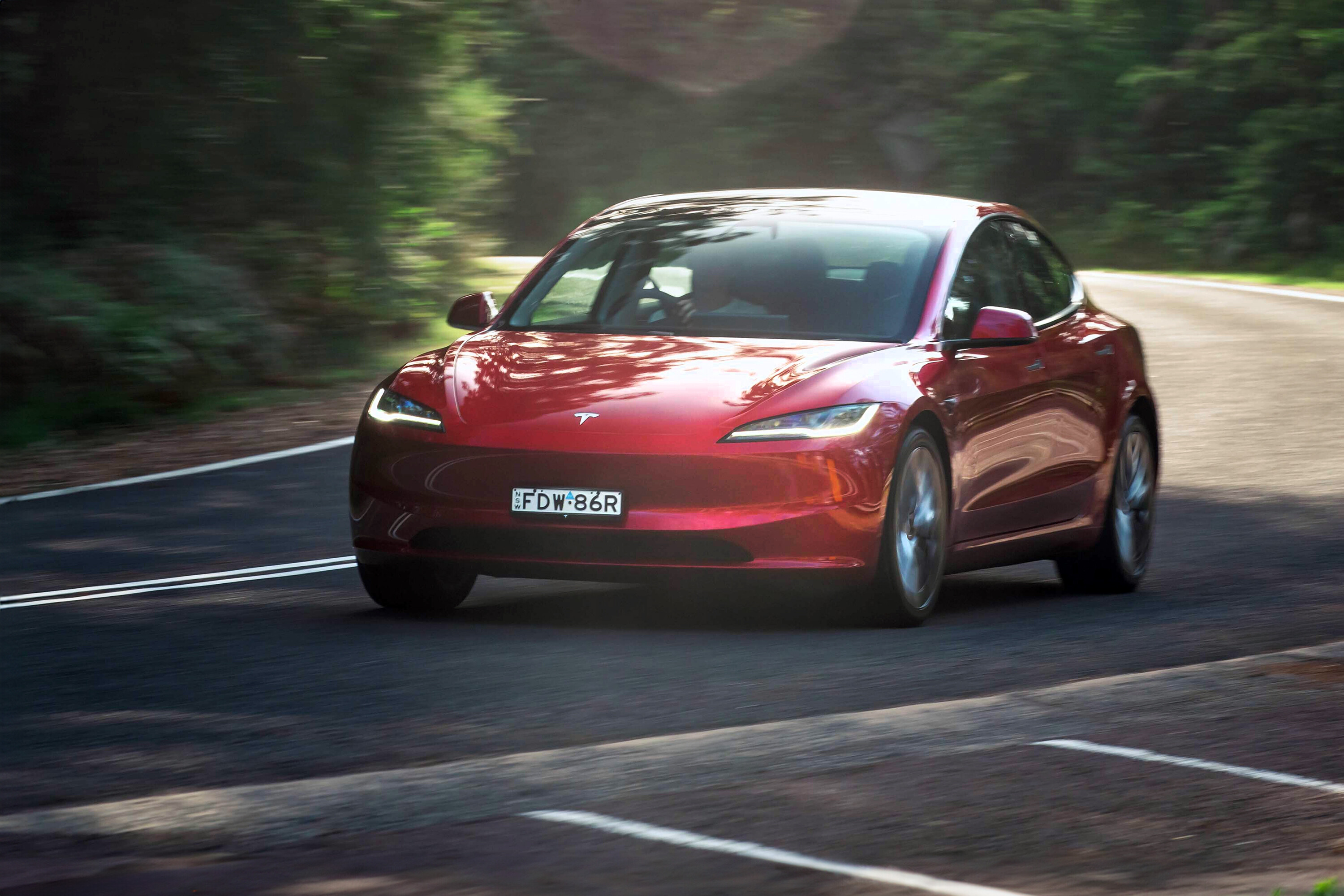
What is the Tesla Model 3’s towing capacity?
Tesla Model 3 EVs fitted with a towing package are rated to tow up to 1000kg braked or 750kg unbraked.
Tesla recommends using an approved roof rack, and it sells a first-party accessory in Australia for $705, capable of carrying up to 68kg.
All Tesla Model 3s have a maximum payload of 439kg. Remember that the more weight in the vehicle (including the tow ball download), the less the towing capacity is.
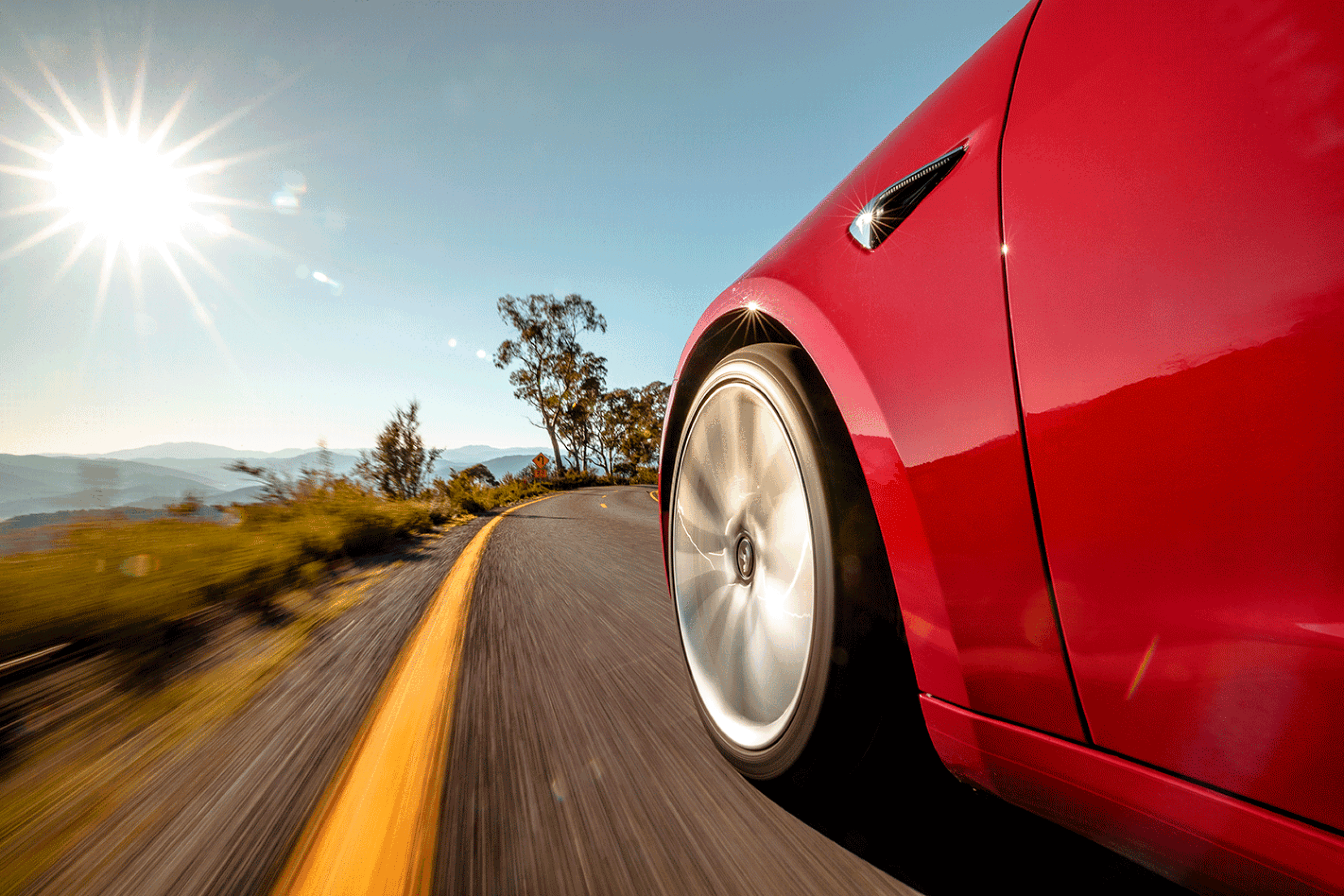
How long is the warranty and what are the Tesla Model 3’s servicing costs?
The Tesla Model 3 is backed by a four-year/80,000km vehicle warranty, which is shorter than some competitors.
Not everything is covered by this warranty; the touchscreen and media control unit come with a two-year/40,000km warranty, while the seatbelts and airbag system have a five-year/100,000km warranty.
The base Model 3 RWD carries a standard eight-year/160,000km battery and drive unit warranty, whereas the warranties for the Model 3 Long Range and Performance extend to eight years or 192,000km.
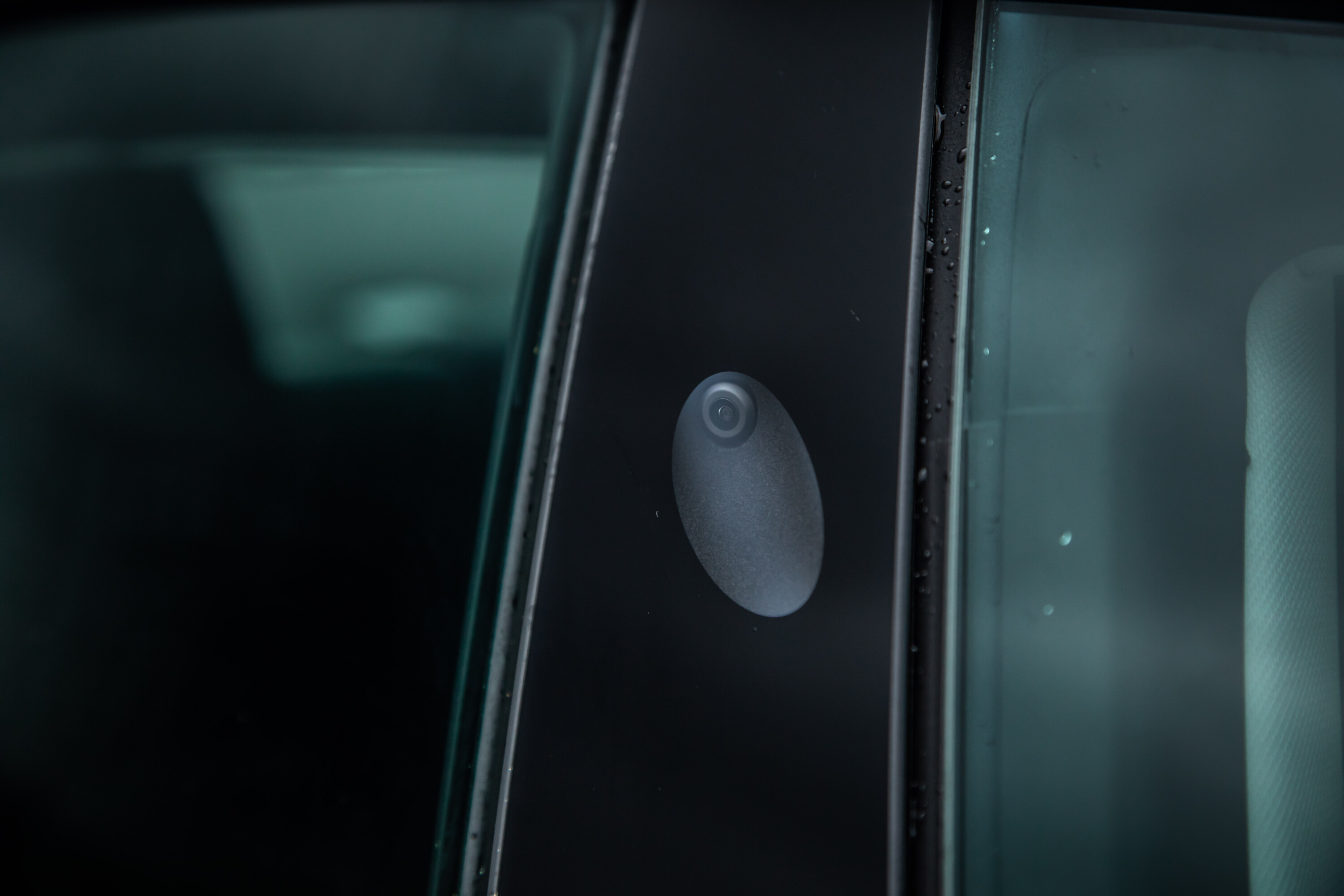
Tesla also provides coverage for battery degradation, promising that all Model 3s will retain at least 70 per cent of their battery capacity within the warranty period.
Under Tesla’s condition-based servicing scheme, the vehicle’s sensors detect when specific parts need maintenance based on usage. The vehicle then notifies the owner via the touchscreen or mobile app to schedule a checkup.
Tesla also recommends a range of routine maintenance tasks, listed here [↗].
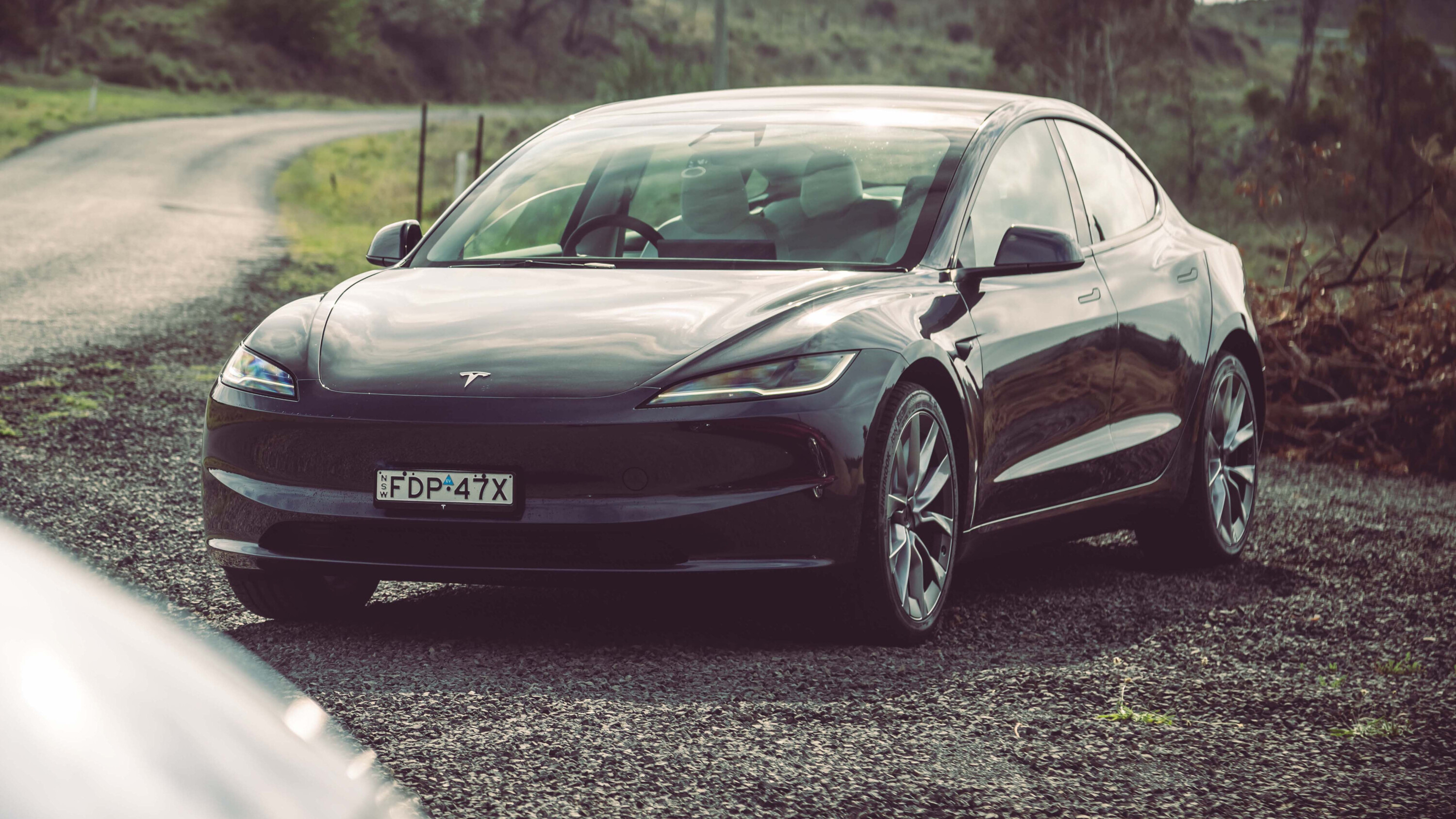
Which version of the Tesla Model 3 does WhichCar recommend?
We would recommend the entry-level Model 3 RWD.
It offers the best all-round value with almost all features included, boasts the most efficiency with a longer-lasting LFP battery, and provides sufficient power for everyday driving.
The differences between the Long Range and Performance models are marginal, as they are essentially distinguished by battery sizes and electric motor count.
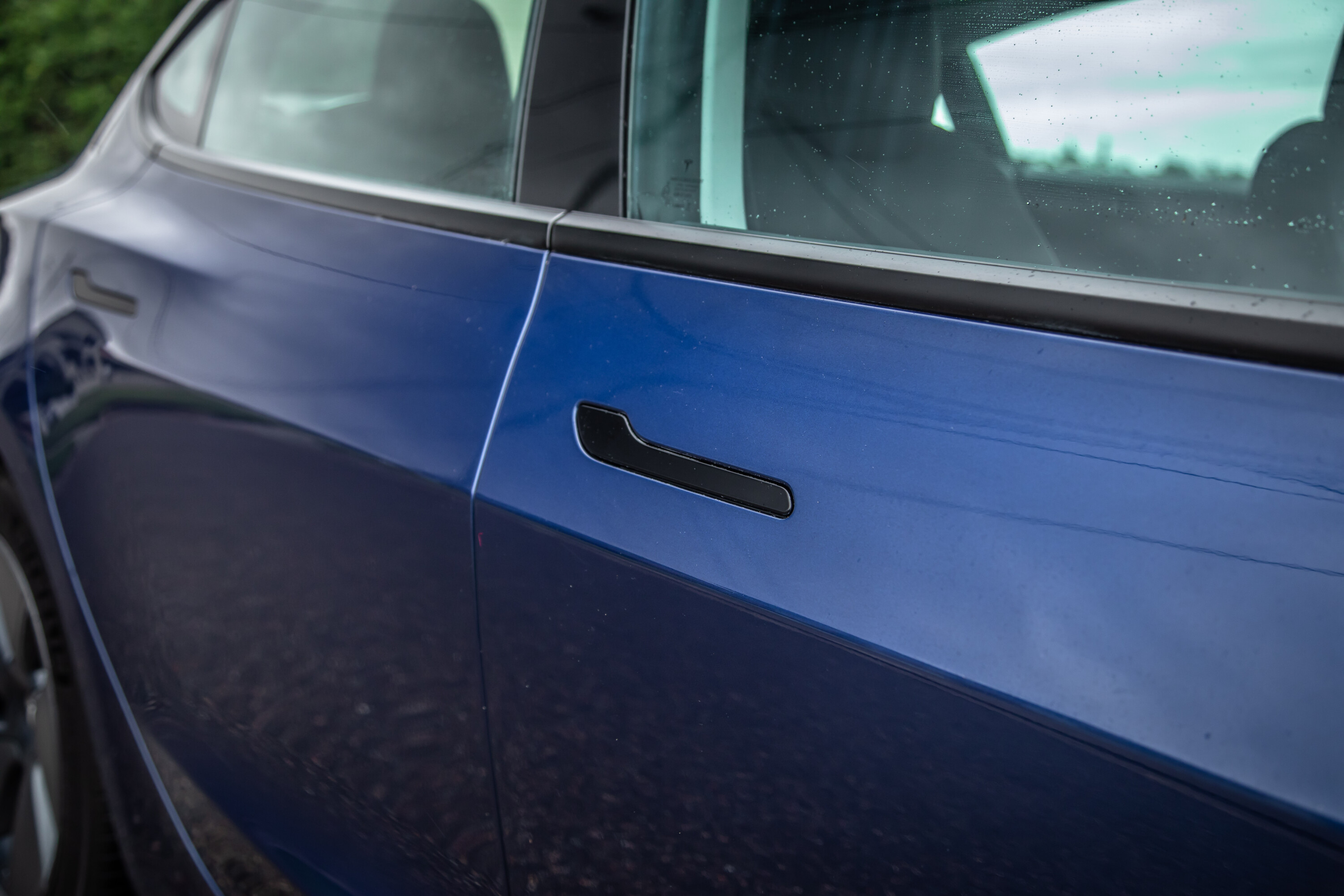
The Performance model does include additional cosmetic and hardware features, but fundamentally, it remains largely the same car; it looks and feels the same from the inside.
For buyers who place a premium on practicality and prefer a more commanding seating position, the slightly pricier Tesla Model Y is worth considering.
What are the Tesla Model 3’s key rivals?
The top-selling Tesla Model 3 finds itself competing with a burgeoning number of small electric cars, including:
ud83dudd3c Back to topWhat might annoy me?
The Model 3‘s passive damping setup can be firm, tending to feel a bit uneasy over uneven bitumen when travelling at low speeds.
However, it does become more comfortable as the speed increases.
As well as being controversially named, Tesla’s ‘Autopilot’ (essentially a marketing term for adaptive cruise control and lane centring assist) is known for its occasional ‘phantom braking’ in some situations.
The Model 3 also lacks an instrument display directly in front of the driver, meaning you’ll need to glance to the left at the central touchscreen for essential information, including the speedometer, drive direction selector, and safety assist visuals.
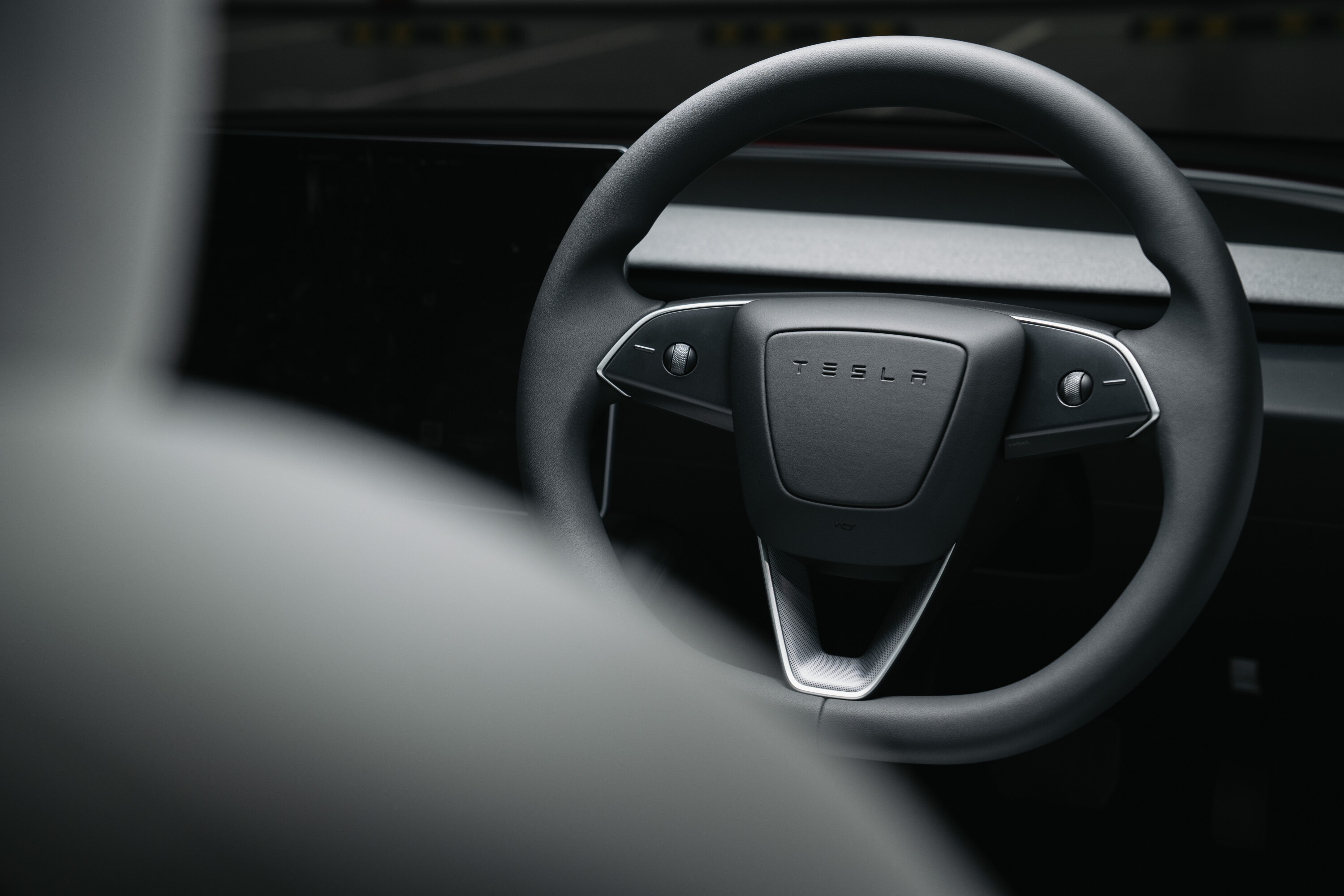
The removal of steering wheel stalks in the updated Model 3 has been controversial. The left and right indicators are now found on the left side of a new-look steering wheel, which can take some time to get used to.
Another change that requires some adjustment compared to other cars is the new touch-based gear selector. The driver now scrolls up or down a ‘transmission bar’ on the right side of the central touchscreen for Drive or Reverse, respectively. Or, alternatively, there are PRND buttons overhead between the sun visors.
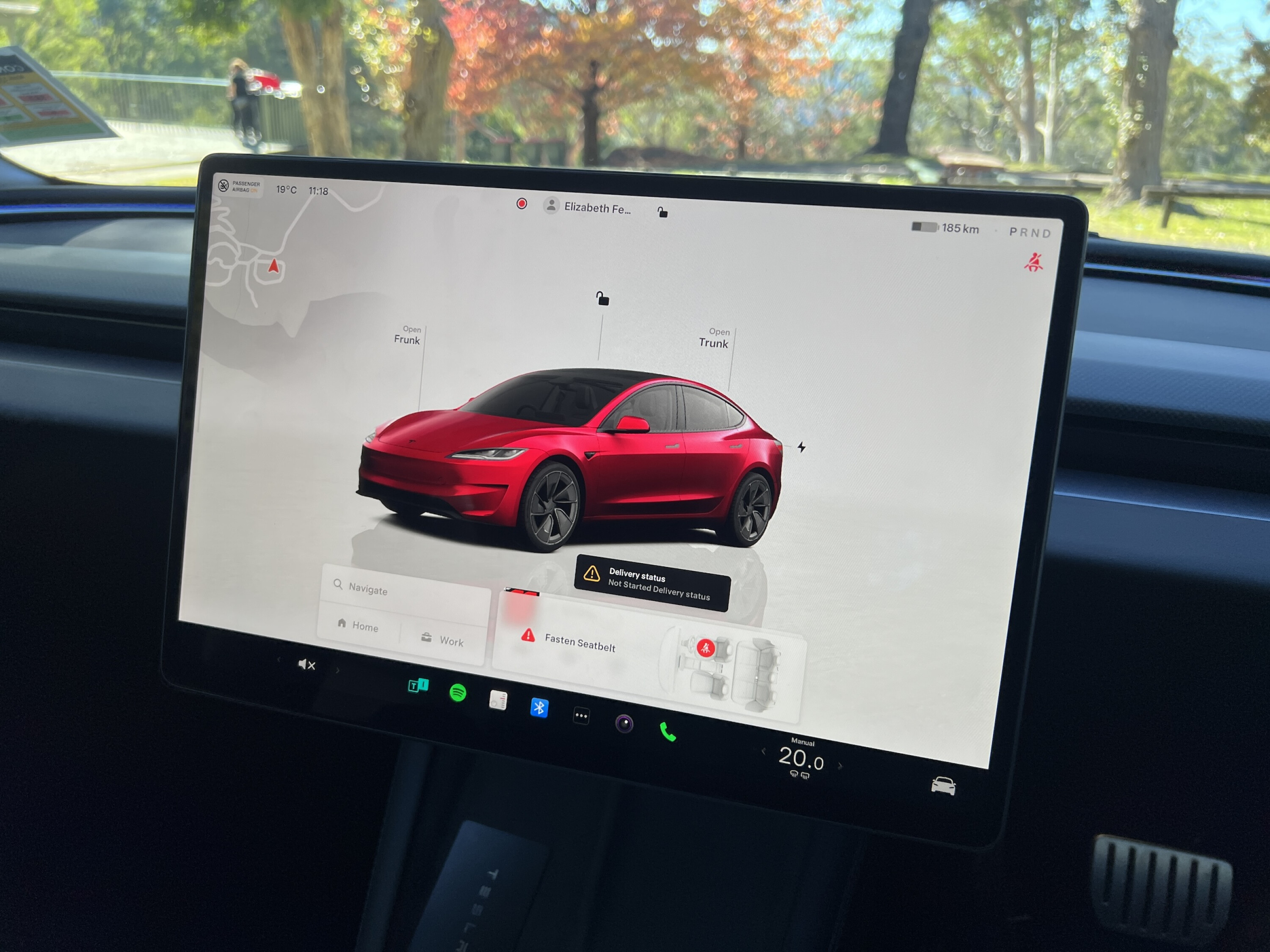
Does any upgrade have a downside?
Typically for all cars, the ride becomes harder and the interior is noisier when fitted with the larger, lower-profile optional 19-inch wheels, and the 20-inch rims standard on the Performance model.
Going for the $5100 Enhanced Autopilot package brings a suite of features: Navigate on Autopilot (which assists with steering towards highway off-ramps), automatic lane-change assist, automatic parking assist, Summon (which remotely moves the car forwards/backwards), and Smart Summon (which remotely drives the car to the user).
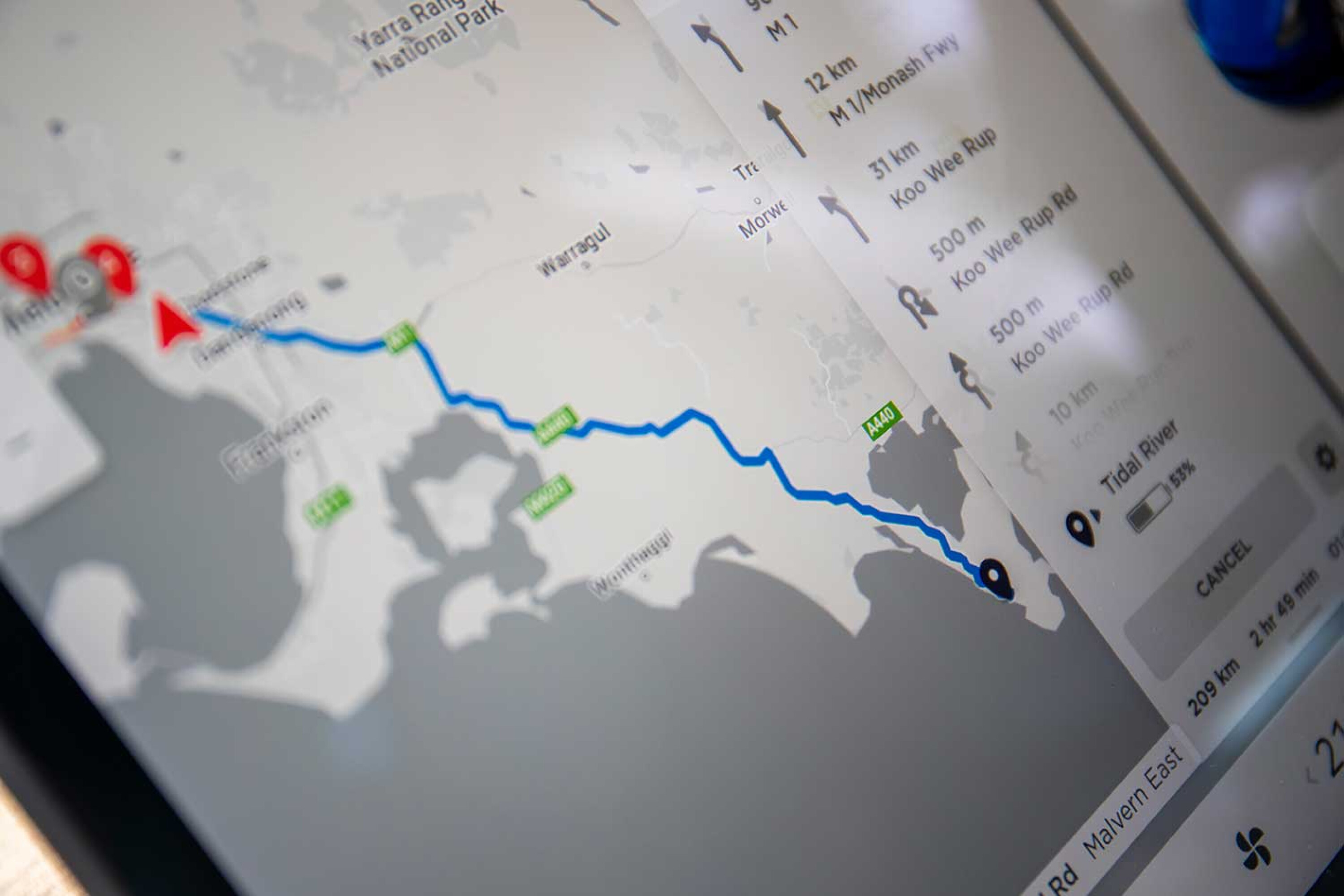
However, these features aren’t essential and haven’t proven to be fully reliable, with Navigate on Autopilot and auto lane-change assist sometimes gratuitously changing lanes.
The $10,100 ‘Full Self-Driving Capability’ package only adds traffic light and stop sign control while in adaptive cruise control (it can still detect them without this option). Tesla has long promised to deliver a game-changing autonomous driving future via this software-enabled pack, but the beta has been unreliable overseas and could be seen as an unnecessary expense.
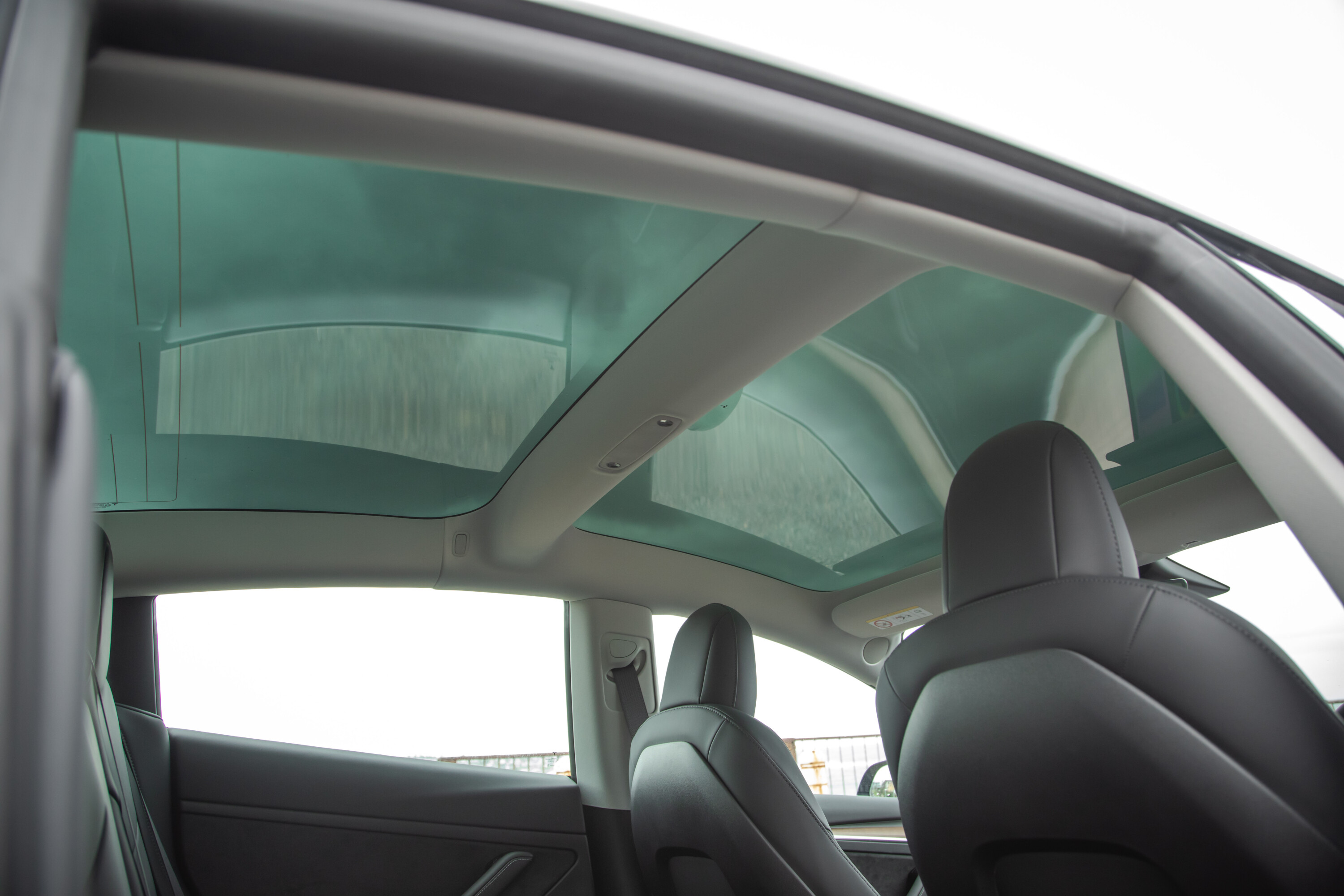
What might I miss that similar cars have?
Unlike many other rival EVs, the Model 3’s minimalist interior lacks an instrument cluster display directly in front of the driver.
Tesla’s touchscreen forgoes the use of Apple CarPlay and Android Auto smartphone projection systems, favouring its own built-in software and applications instead.
Additionally, the Model 3 lacks a rear bumper radar, meaning it’s missing rear cross-traffic assist. It does, however, use side-facing cameras for blind-spot indicators built into the upper speaker grilles, along with a blind-spot camera view.
The latest Model 3 does not use front and rear ultrasonic parking sensors in Australia, instead relying on camera-based distance estimations.
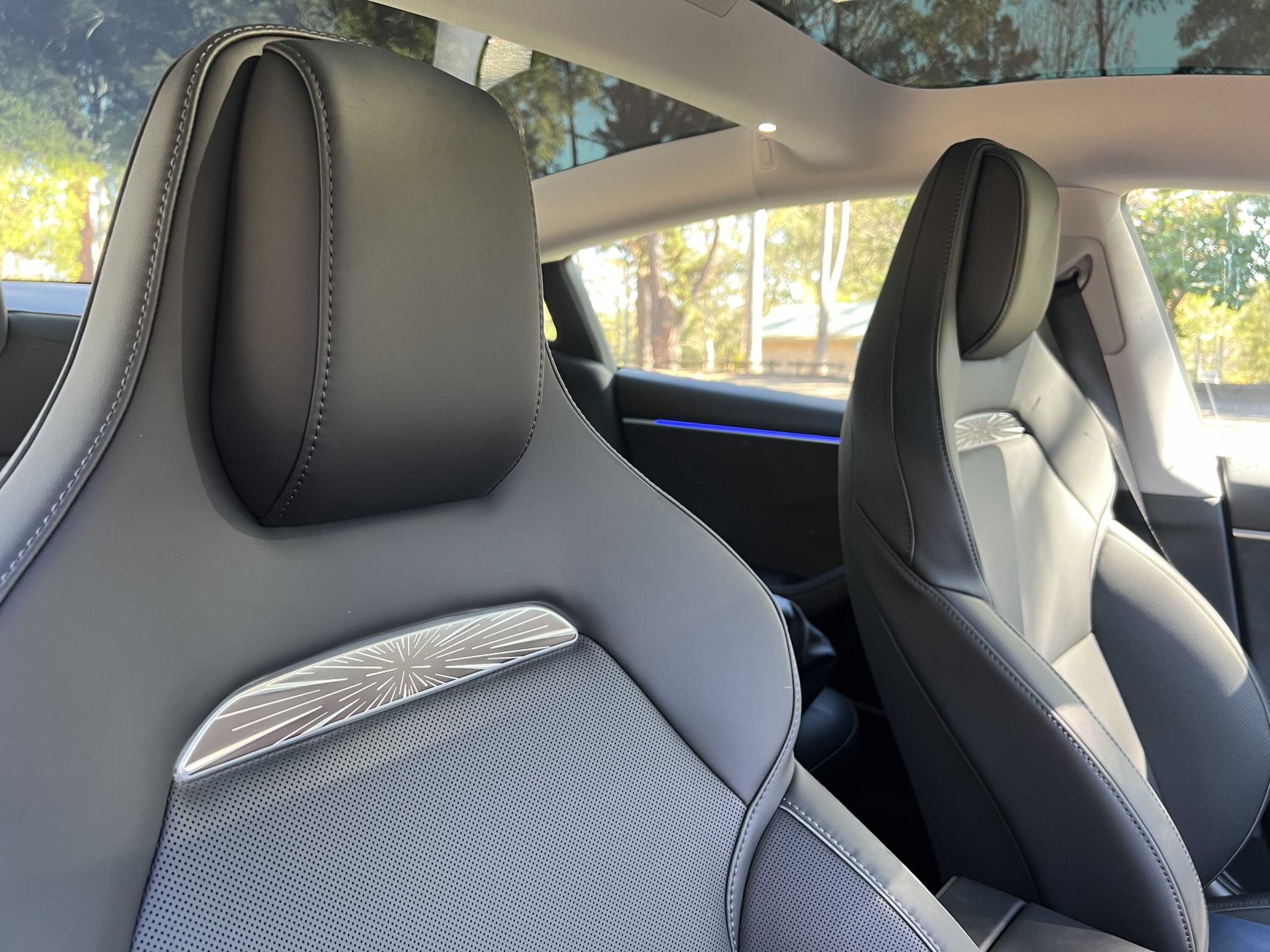
Compared to the related Tesla Model Y SUV, the Model 3 doesn’t have a centre crossbar interrupting the fixed panoramic glass roof and it boasts a stronger high-efficiency particulate filter (HEPA) for the cabin.
Additionally, all newly-delivered Model 3s no longer include a three-pin home trickle charging cable. This means you’ll need to purchase it separately from Tesla for $550, buy from a third party, or opt for a higher output AC wall box installation instead.
What’s the infotainment system like?
The Model 3’s 15.4-inch horizontally-oriented touchscreen uses Tesla’s proprietary operating system, capable of receiving over-the-air (OTA) software updates.
It features built-in Google Maps navigation, including automatic Tesla Supercharger stop planning, as well as music and video streaming apps such as Apple Music, Spotify, and Netflix. Arcade games and built-in voice control are also included.
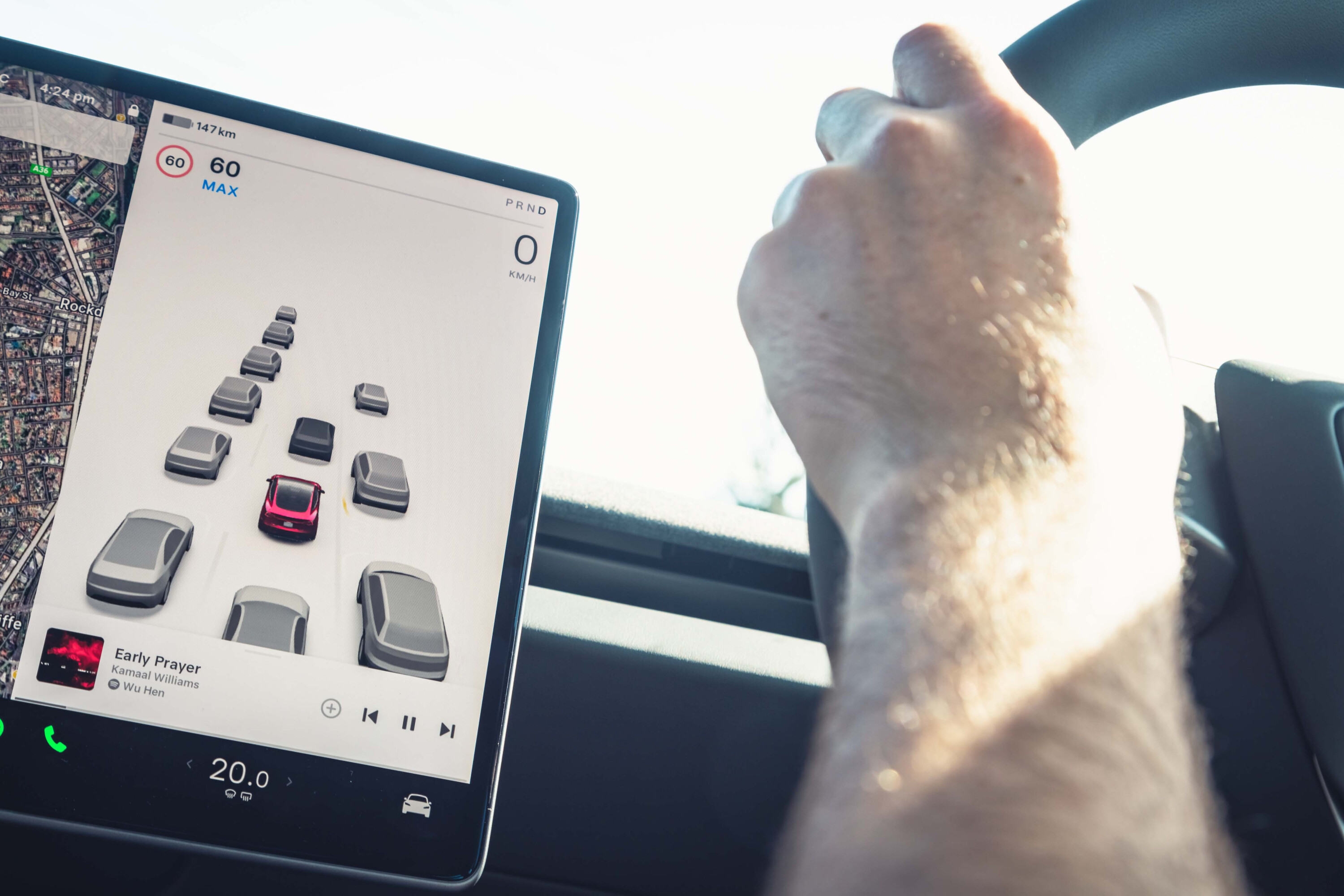
Tesla’s software remains unmatched in the automotive industry, boasting a modern and intuitive user interface, slick animations, and power from a fast AMD Ryzen processor. After all, Tesla is known first and foremost as a technology company.
However, the Model 3’s interface is more crucial than in most cars because it’s responsible for about 95 per cent of the vehicle’s controls and functions. This includes adjusting the steering wheel and wing mirrors, as well as directing the airflow from the air vents.
There is a learning curve involved, and we initially found ourselves distracted for longer periods while trying to figure out various functions.
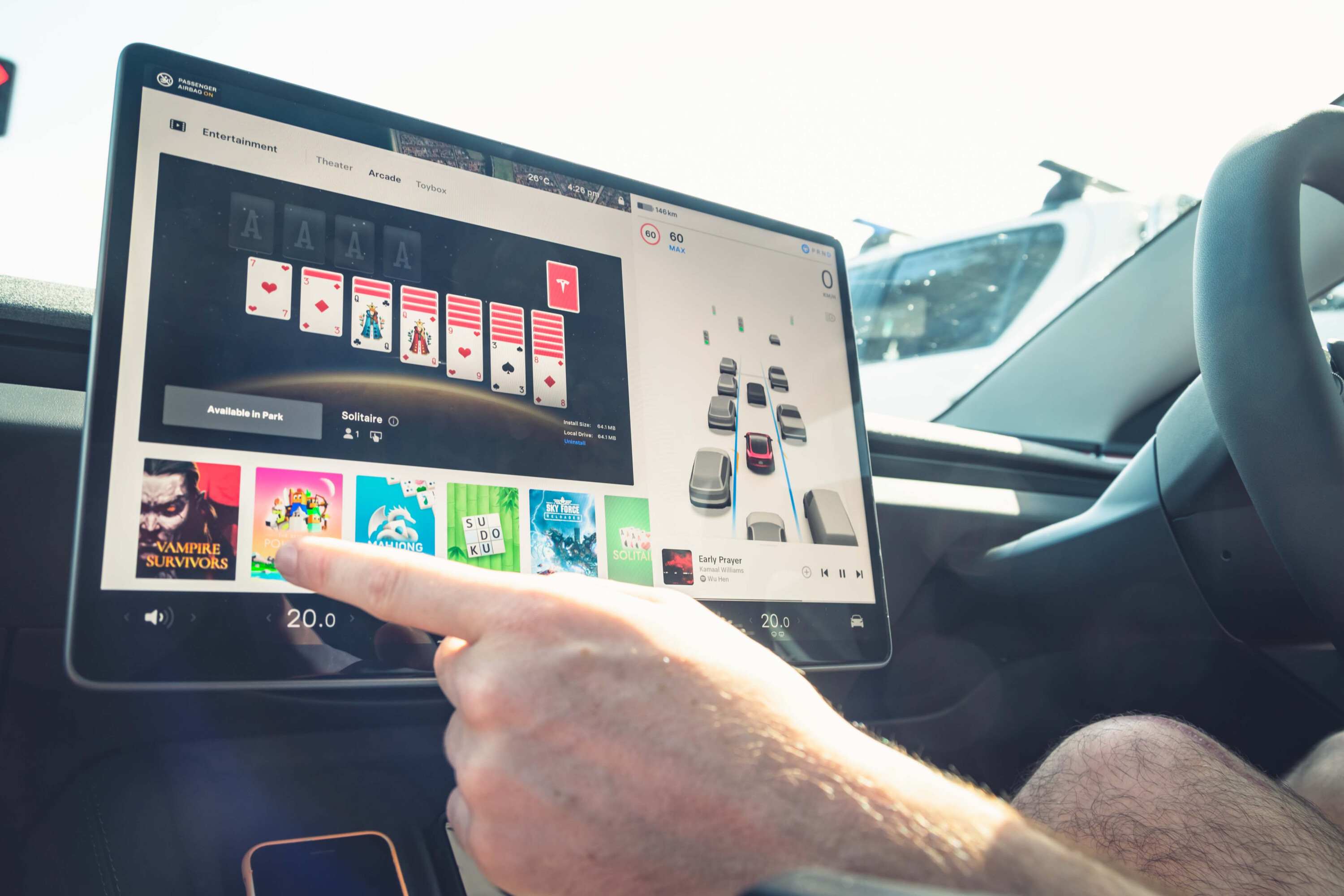
Where is the Tesla Model 3 made?
The Tesla Model 3 for the Australian market is produced in Shanghai, China, at what is referred to as ‘Giga Shanghai’ or ‘Gigafactory 3’.
Are there plans to update the Model 3 soon?
The Tesla Model 3 recently received a significant update.
Following a subtle refresh in 2021, the electric sedan now features a revised exterior design, a stalkless steering wheel set-up, higher-resolution ‘Hardware 4.0’ camera, and improved driving range.
Unlike traditional car brands, Tesla tends to make frequent ‘running’ hardware changes to its cars, often without notice, in addition to delivering consistent over-the-air (OTA) software updates for existing owners.
More EV stories to help you choose the best car for your needs
- ? EV news, reviews, advice & guides
- ❓ Short & sweet: Your EV questions answered
- ⚡ New EVs: Everything coming to Australia
- ? Australia’s EVs with the longest driving range
- ⚖️ Best-value EVs by driving range
- ? How much do EVs cost in Australia?
- ? How much more expensive are EVs?
- ⚖️ Number crunching: Is it time to switch to an EV?
- ♻ Should you buy a used EV?
- ?️ Are EVs more expensive to insure?
- ? Costs compared: Charging an EV vs fueling a car
- ? EV charging guide
- ? Are there enough EV chargers in Oz?
- ?? EV servicing explained
- ? EV battery types explained
- ? When do EV batteries need replacing?
- ? Hydrogen v EVs: What’s best for Oz?
- ? How sustainable are EVs, really?
MORE advice stories to help you with buying and owning a car
Score breakdown
Things we like
- Efficiency and performance even on base model
- Advanced, up-to-date tech
- Access to most Tesla Supercharger, Destination chargers
- Modern, improved quality interior
Not so much
- Speedo not in front of driver; no head-up display
- Trickle charging cable no longer included
- Fidgety low-speed ride
- Ambiguous exterior design



